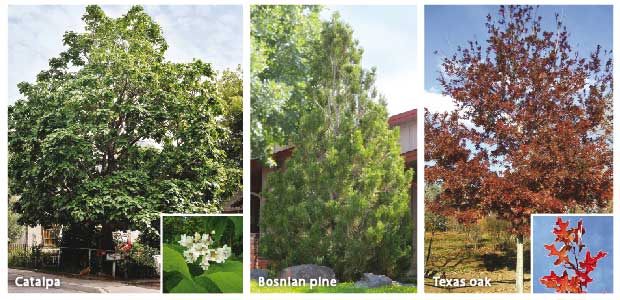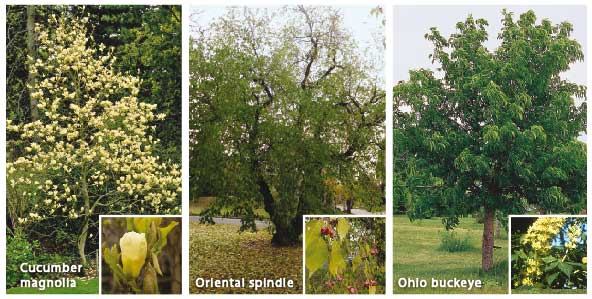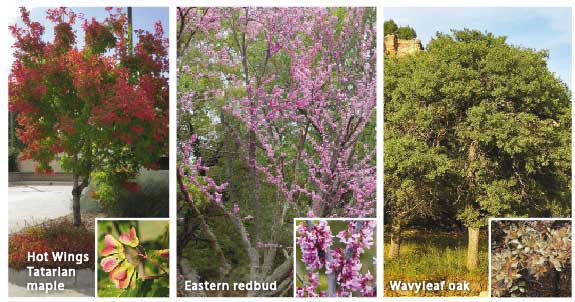Trees for All Seasons
27 Sep 2015
Erratic weather took a toll on local trees last winter and spring. Here are replacement ideas for those that were felled by a lethal combination of frost and heat.
By Panayoti Kelaidis There is no question in my mind that Colorado in general, and Boulder County in particular, present climatic challenges like few places on the planet. In just a few year’s time we can experience flooding, drought and legendary polar-vortex cold fronts that kill native trees outright. And let’s not forget hurricane-force winds and those formidable chinooks. All of these phenomena impact our urban canopy of trees. Toss in pests like emerald ash borer and thousand cankers disease, and homeowners can hardly be blamed for fretting over their trees. Fall’s arctic blast on Nov. 12, 2014, killed four trees in my garden (two cherry trees and two Japanese maples), and damaged several others. With so many compromised trees, what should I replace them with? You too may wonder what outstanding trees can put up with our unpredictable climate. There are hundreds of wonderful trees that could potentially grace our landscapes. I have selected some of my favorite underappreciated trees for this discussion. All of them have been sold by at least a few nurseries in recent years, but you may have to ask your local nursery to special-order them for you from Fort Collins Wholesale Nursery. These trees merit much wider popularity, as they have proven themselves repeatedly in local gardens.Large Trees
(over 40 feet at maturity)
Catalpa (Catalpa speciosa)
It’s true that catalpas have enormous leaves that can be annoying when they shed. And they produce long seedpods that are another nuisance, but surely there are spots where this amazing tree can grace our gardens with its magnificent panicles of white flowers. I grew up on Boulder’s University Hill next to a park with several catalpas that helped ignite my passion for trees. The impressive flowers yield a sweet sap, and many times I sucked on these blossoms as a child. The bold, almost tropical presence of this tree makes for a wonderful specimen in the right spot. And I have seen catalpas thriving with almost no irrigation. They are one tough tree!Bosnian pine (Pinus heldreichii)
Ponderosa pine constitutes the commonest tree in the foothills to our west (although it doesn’t always perform well in urban gardens, as it hates irrigation). There are probably 100 kinds of pines that could grow well in Boulder County, although I only know of perhaps a dozen species that have actually proven their mettle. Of these, the Bosnian pine is my favorite. A cousin to Austrian pine (Pinus nigra), this Balkan native seems to be resistant to several pests that are causing problems for Austrian pines in the Midwest, and potentially could threaten them here. The Bosnian pine is darker and somewhat denser in growth than other pines, and upright in habit. It tolerates a wide spectrum of soils and exposures, growing slowly but gracefully into spectacular maturity. If you want a larger conifer, I think this is the perfect pine tree for Colorado.
A cousin to Austrian pine (Pinus nigra), this Balkan native seems to be resistant to several pests that are causing problems for Austrian pines in the Midwest, and potentially could threaten them here. The Bosnian pine is darker and somewhat denser in growth than other pines, and upright in habit. It tolerates a wide spectrum of soils and exposures, growing slowly but gracefully into spectacular maturity. If you want a larger conifer, I think this is the perfect pine tree for Colorado.
Texas oak or Buckley oak (Quercus buckleyi)
Despite its common name, the Texas oak grows well beyond the Lone Star State and is found in a few of our better nurseries. It superficially resembles pin oak (Quercus palustris), which is planted quite often in Boulder. The difference? Texas oak tolerates alkaline soils much better (pin oaks can turn chloritic on such soils). Best of all, the Texas oak has a deep taproot and appears to be entirely drought tolerant. We have Texas oaks at Denver Botanic Gardens that have never been irrigated but have formed beautiful, tall specimens that stay lush and green through the worst of our droughts. Texas oak is rather fast growing and predictably produces fantastic fall colors—wonderful reds and oranges—every November. I believe this is THE oak tree for Colorado.Medium Trees
(20 to 40 feet at maturity)
Cucumber magnolia (Magnolia acuminata ‘Elizabeth’)
Magnolias fill our hearts with trepidation: They are so often frosted just before or while in bloom that many Coloradans hesitate to plant them. Those who do, however, find that magnolias love our gardens—especially Boulder County’s more acid soils—and grow quickly into beautiful, shapely trees. More and more hybrids are appearing that have crossed the Asian bright spring bloomers with the more modest summer-blooming American species. These hybrids usually bloom a few weeks after the typical saucer magnolias, and bloom more reliably in Colorado’s unsettled springs (many produce bright-yellow flowers). If you tuck these on the north side of a building or in a protected spot, you’re apt to have a predictably lavish display of color in our climate—no easy feat. Seek out the yellow hybrids if you want a magnolia; ‘Elizabeth’ is one of the toughest and most frequently sold.
These hybrids usually bloom a few weeks after the typical saucer magnolias, and bloom more reliably in Colorado’s unsettled springs (many produce bright-yellow flowers). If you tuck these on the north side of a building or in a protected spot, you’re apt to have a predictably lavish display of color in our climate—no easy feat. Seek out the yellow hybrids if you want a magnolia; ‘Elizabeth’ is one of the toughest and most frequently sold.
Oriental spindle tree (Euonymus bungeana)
It may take some searching to find this amazing tree. If your local nursery doesn’t carry it, suggest they special-order it for you. A hundred years ago, Saco Rienk DeBoer (city of Denver landscape architect from 1910-1931) planted dozens of this tree in various city parkways. Today, they are gorgeous mature specimens with great character, soft green leaves all summer and bright-yellow fall color. The masses of red fruit in late summer are quite showy as well. Many euonymus suffered in this past winter’s untimely frosts, but the Oriental spindle trees came through with flying colors. I planted one in a dry spot and it seems to thrive on neglect and drought. I believe this tree should be grown far more often than it is.Ohio buckeye (Aesculus glabra)
One occasionally sees Ohio buckeyes here and there along the Front Range. There may even be a few hundred of them planted about, but that’s not nearly enough. This wonderful tree doesn’t get as massive or produce the dense shade of its more popular European cousin, the horse chestnut (Aesculus hippocastanum), but I believe the Ohio buckeye’s more modest size is a plus. This tree has a host of other qualities to recommend it, including a wonderful bearing with a shapely, rounded form that looks very gracious from a distance. The medium-green leaves are beautifully shaped, and turn outrageous orange and even scarlet in fall. If you can buy this tree in fall, I’m sure you will find a buckeye with autumn leaves that rival the brightest maple. Best of all, Ohio buckeye tolerates drier conditions than most trees. It appreciates an occasional drink, but can endure drought and dry sites better than most any non-native tree.Small Trees
(under 20 feet at maturity)
Hot Wings Tatarian Maple (Acer tataricum ‘Hot Wings’)
Developed by Fort Collins Wholesale Nursery, this fantastic tree has become popular worldwide and is promoted by the Plant Select program. One often sees Amur maples (Acer ginnala) around Boulder, fine trees in their own right. Tatarian maple is closely related to Amur maple, but it tolerates more alkaline soils (Amur maple bleaches yellow on limy soils). Hot Wings has seeds that turn brilliant red as they mature, making it look as though it’s blooming for months in the summer. It thrives in our area and takes drought in stride—the perfect compact tree.Eastern Redbud (Cercis Canadensis)
I do not deny that redbuds occasionally have their flowers frosted in an untimely spring cold snap. But I have observed over the decades that many seem to escape the worst frosts if planted in somewhat protected spots. This tree blooms reliably enough to merit more frequent planting. You do find redbuds in quite a few local gardens, but in a good spring like this year’s their flowers can last for weeks and paint a vivid picture in our landscapes. More importantly, redbuds seem to love Colorado. There are ancient specimens with rugged trunks in the older parts of Boulder and Denver that may be 100 years old. They seem to sail through horrible winters like this last one unscathed. I visited Tennessee this past springtime during redbud season, and noticed most of the trees there were much smaller than ours. When I asked why, I discovered that in nature redbuds often have native pests like borers that kill them before they attain maturity. We don’t seem to have those pests here, and there are not many trees that we can boast grow better for us than they do elsewhere! Redbuds are surprisingly drought tolerant, too.
More importantly, redbuds seem to love Colorado. There are ancient specimens with rugged trunks in the older parts of Boulder and Denver that may be 100 years old. They seem to sail through horrible winters like this last one unscathed. I visited Tennessee this past springtime during redbud season, and noticed most of the trees there were much smaller than ours. When I asked why, I discovered that in nature redbuds often have native pests like borers that kill them before they attain maturity. We don’t seem to have those pests here, and there are not many trees that we can boast grow better for us than they do elsewhere! Redbuds are surprisingly drought tolerant, too.












